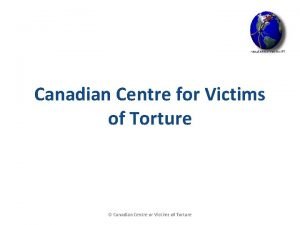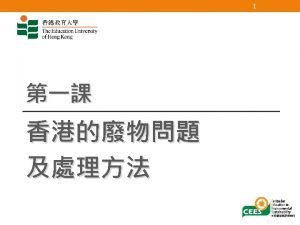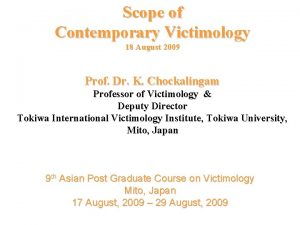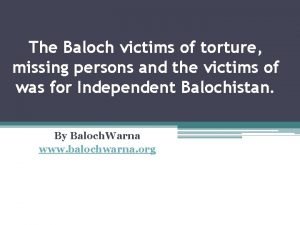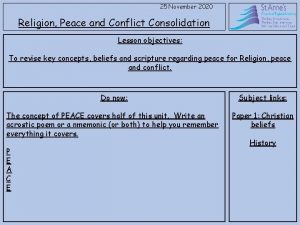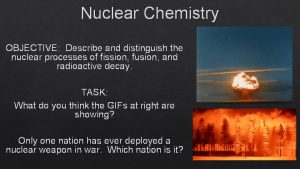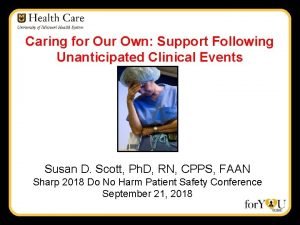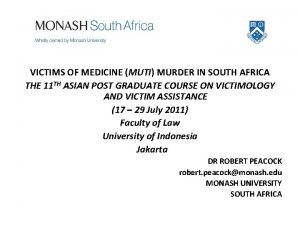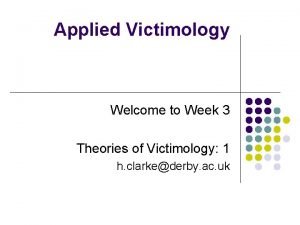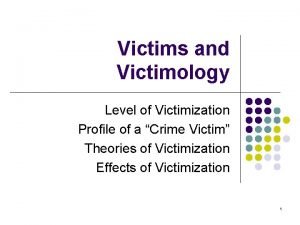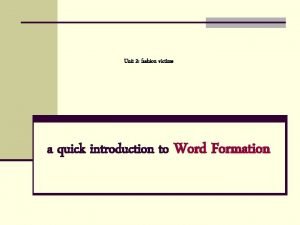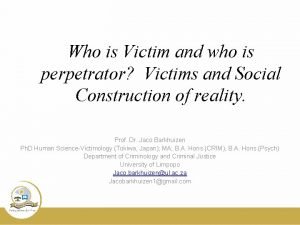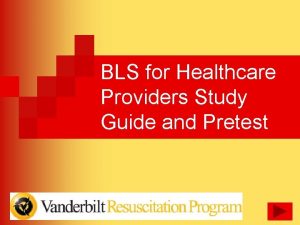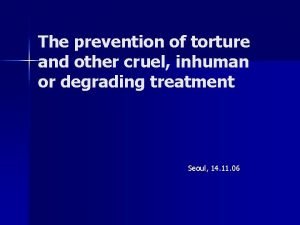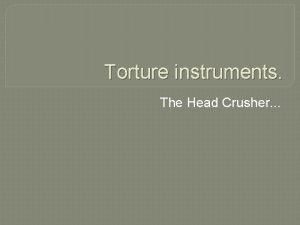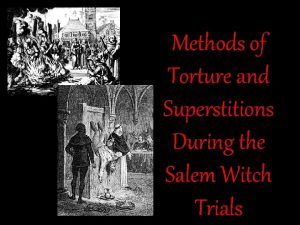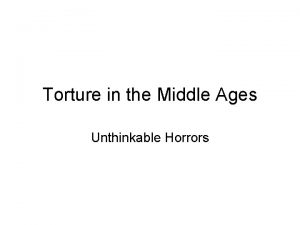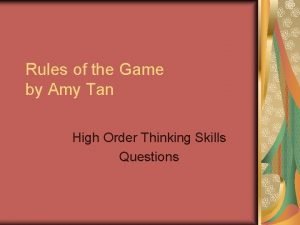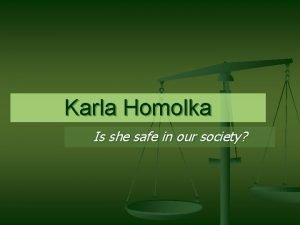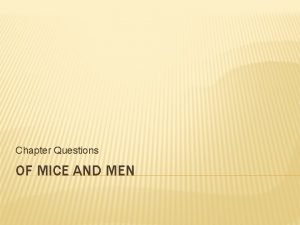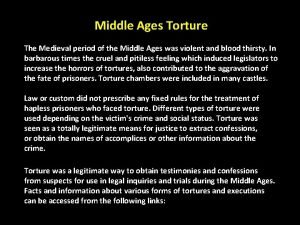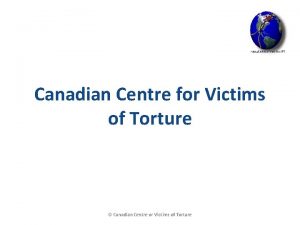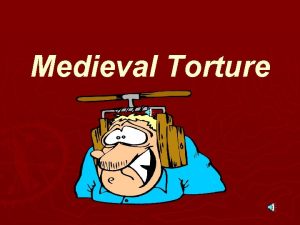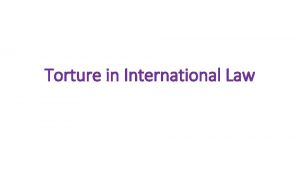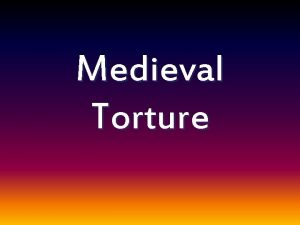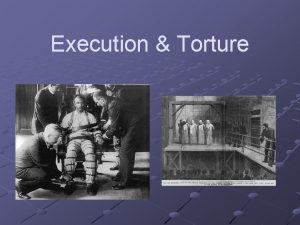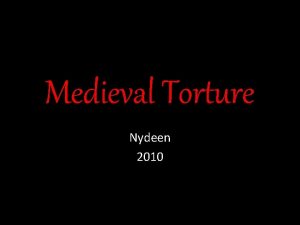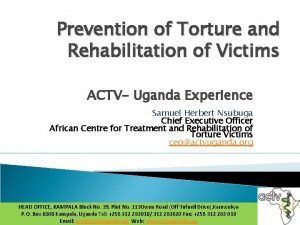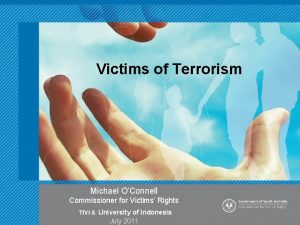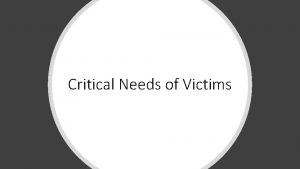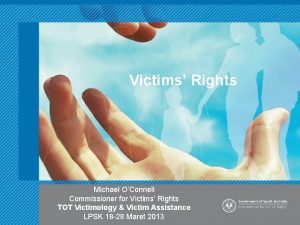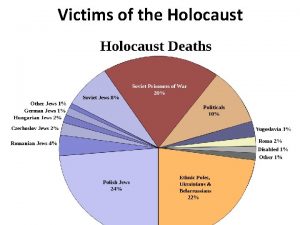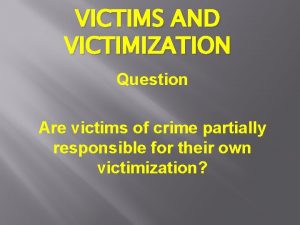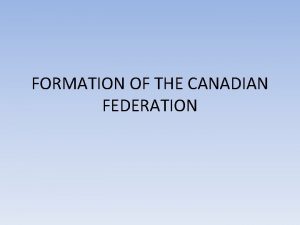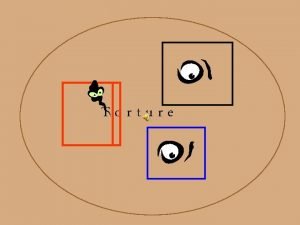Canadian Centre for Victims of Torture Canadian Centre










































- Slides: 42

Canadian Centre for Victims of Torture © Canadian Centre or Victims of Torture

Agenda • • Description of CCVT’s services Definition of torture and organized violence Types of torture/organized violence Impact of torture on survivors, families, and communities Challenges/barriers to healing during re-settlement CCVT’s model of service delivery Tips for working with survivors Vicarious Trauma © Canadian Centre or Victims of Torture

CCVT’S MANDATE The Canadian Centre for Victims of Torture (CCVT) aids survivors in overcoming the lasting effects of torture and war. In partnership with the community, the Centre supports survivors in the process of successful integration into Canadian society, works for their protection and integrity, and raises awareness of the continuing effects of torture and war on survivors and their families. The CCVT gives hope after the horror. © Canadian Centre or Victims of Torture

Did you know… • Founded in 1977 by several CCVT Programs Toronto doctors, lawyers and • Mental Health social service professionals • Support Groups • Centre was the second such • Crisis Intervention facility in the world to be • Settlement Services established • Referral to professional services • Its name has been changed from the Canadian Centre for • ESL/ Computer the Investigation and • Children & Youth Program Prevention of Torture to the Canadian Centre for Victims of • Public Education • Volunteer Program Torture in 1988 • Assisted approximately 20, 000 survivors from over 150 different countries © Canadian Centre or Victims of Torture

United Nations Convention Against Torture and Other Cruel, Inhuman or Degrading Treatment and Punishment PART I, ARTICLE I For the purposes of this Convention, the term "torture" means any act by which severe pain or suffering, whether physical or mental, is intentionally inflicted on a person for such purposes as • Obtaining from him or a third person information or a confession, • punishing him for an act he or a third person has committed, • or intimidating or coercing him or a third person, • or for any reason based on discrimination of any kind, when pain or suffering is inflicted by or at the instigation of or with the consent or acquiescence of a public official or other person acting in an official capacity. © Canadian Centre or Victims of Torture

World Health Organization Concept of Organized Violence (1986) – The inter-human infliction of significant, avoidable pain and suffering by an organized group according to a declared or implied strategy and/or system of ideas and attitudes. It comprises any violent action that is unacceptable by general human standards and related to the victims' feelings. – Organized violence includes torture, imprisonment without trial, mock executions, hostage taking, disappearances or any other form of violent deprivation of liberty. © Canadian Centre or Victims of Torture

Common Techniques of Torture • • • beating electric shocks burning mutilation suffocation use of drugs • sham execution • sexual violence • forced witness • threats, false accusations and violent abuse © Canadian Centre or Victims of Torture

Techniques of Organized Violence • interrogation of friends and family, including children • massacres • Disappearances • institutional lies, censorship and distortion • Arbitrary arrests/imprisonment • banning of public, group, cultural activities • military or police raids of home, school, workplace © Canadian Centre or Victims of Torture

Impact of Torture and Organized Violence • • • Physical pain, transitory and chronic broken bones and joint pain damaged teeth and gums infertility and sterility impotence hearing impairment © Canadian Centre or Victims of Torture

Impact of torture and organized violence Psychological • • Anxiety Panic Attacks Depression, lack of interest or pleasure Suicidal thoughts Guilt, including survivor guilt Paranoia and suspiciousness, hypervigilant Lack of trust/problems trusting authority Phobias, multiple fears • Sleep disturbances • Loss of appetite • Marked irritability, aggressiveness, outbursts • Lack of concentration • Problems with memory • Avoidance of persons or places • Social isolation • Diminished ability to experience intense ranges of emotion • Loss of hope • Hypersensitivity © Canadian Centre or Victims of Torture

Post Traumatic Stress Disorder • Intrusive symptom – i. e. persistent dreams of the traumatic event; flashback episodes • Hyper arousal symptoms – i. e. sleep disorders; irritability or bursts of anger • Avoidance symptoms – i. e. feelings of detachment; restricted range of affect © Canadian Centre or Victims of Torture

Effects of Trauma • Family Trauma • Social Trauma © Canadian Centre or Victims of Torture

Barriers to healing and rehabilitation Settlement issues: Poverty, Immigration status, Lack of Housing, Educational barriers, Lack of Information about Rights, about how to navigate Canadian society, Access to Services, etc. Uncertain future Barriers to Accessing Services: Distrust of authority/societal systems, stigma associated with mental health, linguistic/cultural barriers Lack of family reunification Language Social Isolation Identity/Belonging/Living in Exile Systemic issues (Oppression & Marginalization) Children/Youth: Intergenerational conflicts © Canadian Centre or Victims of Torture

Psychosocial Trauma and Destruction By Ignacio Martín-Baró • The nature of the trauma rests in its social origins • Both the individual victim and the precipitating social causes require treatment and remedy • The trauma will remain chronic when the factors that brought it about remain intact © Canadian Centre or Victims of Torture

Denial - Circles of Silence • Chooses to ignore • Represses experience • Feels threatened and fearful to intervene • Wants to protect others from painful event • Does not expect understanding or to be believed • Feels powerless to assist or change circumstances • Blames the victims • Does not want to concede power to torturer by admitting to traumatic consequences Individuals • Does not want to be concerned with “outside issues” • Wants to protect loved ones • Never speaks of traumatic experience Community Family © Canadian Centre or Victims of Torture • Isolates from relatives, friends, support services • Wants to go forward and forget traumatic event

Overcoming Denial - Circles of Support • Provides opportunities for justice and recognition • Finds understanding and support Individuals • Education, health and social services available and accessible • Learns coping skills to buffer traumatic effects • Constructs a “meaning” • Creates conditions to initiate social reconciliation • Is positively acknowledged by family and society • Establishes commemorative practices to recognize survivors and those who did not survive • Develops understanding • Acquires supportive skills • Recognizes traumatic effects on family Community • Forms link to community Family © Canadian Centre or Victims of Torture

Tips for service providers • Minimize potential stressors (i. e. welcoming and safe office environment, be patient, awareness of re-traumatizing factors) • Be clear about your role, and the way it may be appropriate for you to respond to the survivor, given that role. © Canadian Centre or Victims of Torture

Tips for service providers ØSurvivors have different experiences, represent every type of personality, and level of functioning ØSurvivors are not simply victims, focus on strengths, innate resiliency. © Canadian Centre or Victims of Torture

Tips for service providers Ensure that the agency of the individual is respected • Assure confidentiality, avoid intrusive questioning © Canadian Centre or Victims of Torture

Vicarious Trauma: Definitions • “Refers to the cumulative transformative effect on the helper working with the survivors of traumatic life events” • Process of change that occurs when a provider cares about others who have been hurt, and feels responsible/committed to help. • Results from psychological and spiritual disruptions that affect the way we see ourselves, the world, and what matters most to us. This leads to physical, psychological, spiritual, relational and behavioural symptoms of VT. © Canadian Centre or Victims of Torture

VICARIOUS TRAUMATIZATION Over identification · Over empathizes with survivor · Becomes paternalistic · Unrealistic expectations · Cannot stop thinking about trauma · Believes self to be the only person who can help · Unable to assist Negative Extreme Avoidance · · Loss of empathy Closed to survivor Cynical expectations Does not want to think about trauma · Believes no one can help · Unable to assist Negative Extreme © Canadian Centre or Victims of Torture

Personal Impact of Vicarious Trauma Cognitive • • • • Diminished concentration Confusion Spiciness Loss of meaning Decreased selfesteem Preoccupation with trauma Trauma imagery Apathy Rigidity Disorientation Whirling thoughts Thoughts of selfharm or harm toward others Self-doubt Perfectionism Minimization Emotional Behavioural Anxiety Guilt Survivor guilt Shutdown Numbness Fear Helplessness Sadness Depression Hypersensitivity Emotional roller coaster § Overwhelmed § Depleted § Powerlessness • • • § § § § § • • Impatient Irritable Withdrawn Moody Regression Sleep disturbances Appetite changes Nightmares Hyper-vigilance Elevated startle response Use of negative coping (smoking, alcohol, other substance misuse) Accident proneness Losing things Self-harm behaviors Spiritual • • • Questioning the meaning of life Loss of purpose Lack of selfsatisfaction Pervasive hopelessness Anger at God Questioning of prior religious beliefs Interpersonal • • Decreased interest in intimacy or sex Mistrust Isolation from friends Impact on parenting (protectiveness, concern about aggression) Projection of anger or blame Intolerance Loneliness Physical • • Sweating Rapid heartbeat Breathing difficulties Somatic reactions Aches and pains Dizziness Impaired immune system (Yassen, 1995) © Canadian Centre or Victims of Torture

Second Language Acquisition Working With Survivors of Torture and War Trauma Canadian Centre for Victims of Torture © Canadian Centre or Victims of Torture

Agenda 1. Effects of Torture & war Trauma on Learning 1. Strategies and engagement 1. group activities © Canadian Centre or Victims of Torture

Effects on learning • Memory / Attention fatigue, depression, and somatic symptoms – • Current, ongoing distress – significant factors in their language learning © Canadian Centre or Victims of Torture

Krashen (1982, 1985) • Anxiety and Self-confidence play important role in second language acquisition • Low self-esteem create a mental barrier that prevents comprehensible input from reaching the brain • Lowering anxiety and regain sense of self important for traumatized learners © Canadian Centre or Victims of Torture

Two Important Questions • How can I know if a student has been traumatized if they don’t tell me directly? • What should I do if students disclose shocking personal stories to me? I can’t handle it! © Canadian Centre or Victims of Torture

Tips for service providers • Normalize survivor’s presenting problems and symptoms • Respond sensitively and empathetically, to disclosures of trauma • Reinforce the here and now • Educate yourself about country conditions, cultural and religious factors (i. e. is there religious persecution, political dictatorship, racial discrimination, etc. ) • Educate yourself on community resources available for additional support © Canadian Centre or Victims of Torture

How Can You Create a positive Classroom/Assessment Environment • Class Size, Space • Class length • Class times • Absenteeism • Lateness • School rules © Canadian Centre or Victims of Torture

Attendance • Attendance Challenges are common traits • Attending English class may not be a priority • Survivors deal with Settlement issues/trauma distress • Promoting Attendance requires special attention and strategies © Canadian Centre or Victims of Torture

Memory and concentration Problems • Adjusting classroom/Assessment activities • Repetitions • Tests • Coping wish stress © Canadian Centre or Victims of Torture

Rebuilding Self Esteem • Low self esteem/ feelings of inadequacy are direct effects of torture/ war trauma • Healthy self esteem and high motivation are essential to second language acquisition • Learners take risk in experimenting with a new language and make countless errors in front of classmates, friends and strangers • Rebuilding self esteem/ confidence is long/ complicated process © Canadian Centre or Victims of Torture

Improving self esteem • Encouragement/affirmation • Understanding the effect trauma can have on the learning process • Student empowerment • Communicating with each other © Canadian Centre or Victims of Torture

Teaching Family and Feelings • Depersonalizing • Sharing experiences • Feelings and emotions © Canadian Centre or Victims of Torture

Teaching/Topics Health and the Medical System • Relevant language • Empowerment • Open discussion © Canadian Centre or Victims of Torture

Teaching/Topics of the Human Body • Sensitivity • Demonstrating body parts • Touching © Canadian Centre or Victims of Torture

Adjusting Expectations • Making program adjustments if necessary • Understanding vicarious trauma • Care for the care giver © Canadian Centre or Victims of Torture

flexibility and empathy • modify curriculum/ assessment requirements • deliver lessons/Assessment at a differentiated rate; repeating concepts/ modify activities, more time on assessments, • Reflect on teacher’s/Assessors role, teaching techniques and curricula © Canadian Centre or Victims of Torture

Implications for recovery goals Educators • Restore Control and Safety • Reduce Fear and Anxiety • Rebuild Self Esteem, Attachments and Connections • Help overcome Loss and Grief • Restore Value, Identity, Meaning and purpose Reflect/Be Accountable to what we do © Canadian Centre or Victims of Torture

Support • create social space, Connections, bonding • A befriender • more settlement/counselling support • Enablers, A befriender , transportation support , © Canadian Centre or Victims of Torture

Relationships • Build a class community , build everyday hope together • Understand crucial role of the instructor in relationships. • Strategies: snack events , bulleting board, movie days, trips e. g. Compliments board: post small victories/achievements notices of need for advice/help/ tips etc. . © Canadian Centre or Victims of Torture

Suggested reading/resources • www. ccvt. org • LIP websites ( Local Immigration partnership) http: //www. torontolip. com • Resources for Syria Refugees http: //www. torontolip. com/Home/Syrian. Refugees -Copy. aspx https: //www. porticonetwork. ca/web/rmhp/toolkit /syrian- refugee? intcid=search-results © Canadian Centre or Victims of Torture
 Canadian centre for victims of torture
Canadian centre for victims of torture Canadian centre for victims of torture
Canadian centre for victims of torture Canadian centre for remote sensing
Canadian centre for remote sensing Hyatt regency crown center
Hyatt regency crown center Ideas have consequences bad ideas have victims
Ideas have consequences bad ideas have victims Menachem amir contribution to victimology
Menachem amir contribution to victimology Thourghout
Thourghout Religious beliefs about helping victims of war
Religious beliefs about helping victims of war Shadows of hiroshima victims
Shadows of hiroshima victims Charlene gallego victims
Charlene gallego victims 3 tiers of support for second victim
3 tiers of support for second victim Explain two contrasting understandings of salah.
Explain two contrasting understandings of salah. Characteristics of the victims of muti murders
Characteristics of the victims of muti murders Brandon crunkilton
Brandon crunkilton Drowning victims
Drowning victims Tami lynne tinning
Tami lynne tinning Von hentig's psychological types of victims
Von hentig's psychological types of victims This needed three or more rescuers to form a hammock
This needed three or more rescuers to form a hammock Psychological types of victims
Psychological types of victims Richard trenton chase victims
Richard trenton chase victims Janie mixer
Janie mixer Unit 2 fashion victims answers
Unit 2 fashion victims answers Victimology in criminology
Victimology in criminology After positioning yourself directly above the victims head
After positioning yourself directly above the victims head Dorothea puente younger
Dorothea puente younger The west memphis three crime scene photos
The west memphis three crime scene photos Romeo and juliet acts 1 and 2 quiz
Romeo and juliet acts 1 and 2 quiz Dns water torture
Dns water torture Torture
Torture Skeffington's hours
Skeffington's hours Cyber torture
Cyber torture Head crusher torture
Head crusher torture Squassation torture
Squassation torture Burning bull torture
Burning bull torture Iron spider torture
Iron spider torture The rules of the game by amy tan
The rules of the game by amy tan Karla homolk
Karla homolk Why does crooks torture and taunt lennie about george
Why does crooks torture and taunt lennie about george Knee crushing torture
Knee crushing torture Korta dikter som rimmar
Korta dikter som rimmar Nyckelkompetenser för livslångt lärande
Nyckelkompetenser för livslångt lärande Varför kallas perioden 1918-1939 för mellankrigstiden
Varför kallas perioden 1918-1939 för mellankrigstiden Personlig tidbok
Personlig tidbok
